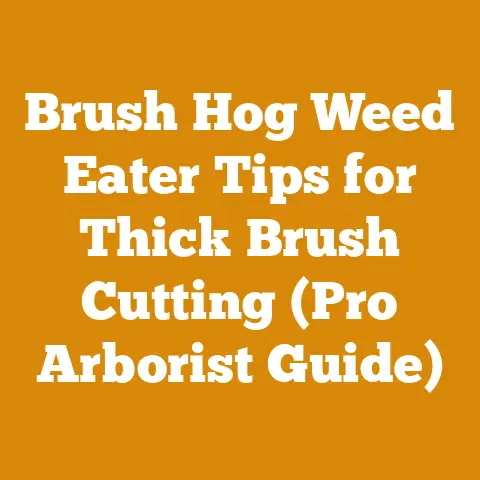How to Sharpen a Chainsaw Blade with a Grinder (5 Pro Tips)
Let’s bust a myth right off the bat: Sharpening a chainsaw with a grinder isn’t some mystical art reserved for seasoned lumberjacks. It’s a skill anyone can learn, and frankly, should learn if they’re serious about chainsaw safety and efficiency. I’ve seen too many folks hacking away with dull chains, risking kickback and burning out their saws, simply because they thought sharpening was too complicated. It’s not! With the right approach, a grinder is your best friend for keeping your chain razor-sharp.
The Importance of a Sharp Chainsaw: More Than Just Cutting Faster
Before we dive into the nitty-gritty, let’s talk about why this matters. A sharp chainsaw isn’t just about cutting wood faster (although it definitely does that!). It’s about:
- Safety: A dull chain requires more force to cut, increasing the risk of kickback, a sudden and violent upward or backward movement of the saw that can cause serious injury. A sharp chain bites into the wood cleanly, reducing this risk. I’ve personally experienced the terror of kickback with a dull chain. Believe me, it’s not something you want to repeat.
- Efficiency: A sharp chain cuts faster and more cleanly, reducing strain on the saw’s engine and your body. You’ll use less fuel, extend the life of your saw, and get more work done in less time. I remember once spending an entire day struggling to fell a relatively small tree with a dull chain. After finally sharpening it, I could have felled three more trees in the same amount of time.
- Saw Longevity: A dull chain forces the saw to work harder, leading to increased wear and tear on the engine, bar, and chain itself. Keeping your chain sharp is a simple way to extend the life of your expensive equipment. I’ve seen saws practically destroyed by neglect. Don’t let that happen to yours!
- Quality of Cut: A sharp chain produces clean, even cuts, which are essential for woodworking projects and even for efficient firewood splitting. A ragged cut wastes wood and makes splitting much harder.
Key Concepts: Understanding Your Chainsaw Chain
Before you start grinding, you need to understand the anatomy of your chainsaw chain. This isn’t just academic; knowing the parts helps you sharpen effectively.
- Cutters (Teeth): These are the heart of the chain, the part that actually does the cutting. Each cutter has two main surfaces:
- Top Plate: The top edge of the cutter that slices through the wood. This is the primary surface you’ll be sharpening.
- Side Plate: The side of the cutter that also contributes to the cutting action.
- Depth Gauges (Rakers): These sit in front of each cutter and control the depth of the cut. They prevent the cutters from biting too deeply into the wood, which can cause kickback and inefficient cutting.
- Tie Straps: These connect the cutters and depth gauges, holding the chain together.
- Drive Links: These fit into the groove of the chainsaw bar and are propelled by the saw’s sprocket, pulling the chain around the bar.
Green Wood vs. Seasoned Wood: This is a fundamental distinction in wood processing. Green wood is freshly cut and has a high moisture content (often above 30%). Seasoned wood, on the other hand, has been dried to a moisture content of around 20% or less. Green wood is generally easier to split when fresh, but seasoned wood burns more efficiently and produces less smoke. I’ve found that oak, for example, splits best when it’s been allowed to dry for a few months.
Step-by-Step Guide: Sharpening Your Chainsaw with a Grinder
Now, let’s get to the sharpening process. I’ll break it down into clear, actionable steps.
Step 1: Gather Your Tools and Materials
You’ll need the following:
- Chainsaw Grinder: There are two main types:
- Bench Grinders: These are stationary grinders that offer more precision and control. I personally prefer a bench grinder for consistent results. Look for one with a fine-grit grinding wheel specifically designed for chainsaw chains. I recommend a wheel with a grit of around 60-80.
- Handheld Grinders (Rotary Tools): These are more portable and less expensive, but they require more skill and practice to use effectively. A Dremel or similar rotary tool with a chainsaw sharpening attachment can work in a pinch.
- Chainsaw Vise: This holds the chainsaw bar securely while you sharpen the chain. A good vise is essential for accurate and consistent sharpening. I prefer a bar-mounted vise that clamps directly to the bar for maximum stability.
- Depth Gauge Tool (Raker Gauge): This is a small tool used to file down the depth gauges to the correct height.
- Flat File: For filing down the depth gauges.
- Gloves: To protect your hands from the grinder and sharp chain.
- Safety Glasses: Absolutely essential to protect your eyes from flying sparks and metal particles.
- Ear Protection: Grinders can be loud, so wear earplugs or earmuffs to protect your hearing.
- Marker: To mark the first cutter you sharpen, so you know when you’ve completed the entire chain.
Tool Specifications:
- Chainsaw: Stihl MS 271 Farm Boss (a versatile saw for general use).
- Grinder: Oregon 519763 Bench Grinder (reliable and easy to use).
- Vise: Granberg Bar-Mount Chainsaw Vise (provides excellent stability).
Step 2: Secure the Chainsaw
Place the chainsaw bar in the vise and tighten it securely. Make sure the chain is free to move along the bar. This is crucial for consistent sharpening. If the bar is wobbly, you won’t be able to achieve accurate angles.
Step 3: Set Up the Grinder
Adjust the grinder’s angle and depth settings according to the manufacturer’s instructions and the specifications for your chainsaw chain. This is where the grinder’s manual becomes your best friend. Most grinders have a guide that helps you set the correct angle for the top plate and side plate of the cutters. I usually start with the manufacturer’s recommended settings and then fine-tune them based on the chain’s performance.
Angle and Depth Settings:
- Top Plate Angle: Typically around 25-35 degrees, depending on the chain type.
- Side Plate Angle: Typically around 60 degrees.
- Depth: Adjust the depth so that the grinding wheel removes a small amount of metal with each pass. You want to sharpen the cutter without overheating it.
Step 4: Sharpen the Cutters
- Mark the Starting Cutter: Use a marker to mark the first cutter you’re going to sharpen. This will help you keep track of where you started.
- Position the Cutter: Position the first cutter so that the grinding wheel aligns with the top plate and side plate.
- Grind the Cutter: Gently lower the grinding wheel onto the cutter, applying light pressure. Grind for a few seconds, removing a small amount of metal. The key is to use light pressure and avoid overheating the cutter. Overheating can weaken the metal and make the chain more prone to breakage.
- Repeat: Repeat the grinding process for each cutter, ensuring that you sharpen each cutter to the same length and angle. Consistency is key to a smooth-cutting chain.
- Rotate the Chain: Rotate the chain to the next cutter and repeat the sharpening process.
- Check Your Work: After sharpening a few cutters, stop and check your work. Make sure the cutters are all the same length and that the angles are consistent.
- Complete the Chain: Continue sharpening each cutter until you reach the marked cutter.
Personalized Story: I remember the first time I used a grinder to sharpen my chainsaw. I was so nervous about ruining the chain that I barely touched the cutters with the grinding wheel. The result was a chain that was still dull. It took me a few tries to get the hang of applying the right amount of pressure and achieving the correct angles.
Step 5: File the Depth Gauges (Rakers)
After sharpening the cutters, you need to file down the depth gauges (rakers). The depth gauges control the depth of the cut, and if they’re too high, the chain won’t cut effectively.
- Use the Depth Gauge Tool: Place the depth gauge tool over the depth gauge. The tool will have different settings for different types of chains.
- File the Depth Gauge: Use a flat file to file down the depth gauge until it’s flush with the top of the depth gauge tool.
- Repeat: Repeat the filing process for each depth gauge.
Important Note: Don’t file the depth gauges too low. If they’re too low, the chain will be too aggressive and prone to kickback. A good rule of thumb is to file them down just enough so that they’re slightly lower than the top of the cutters.
Step 6: Inspect and Test the Chain
Once you’ve sharpened the cutters and filed the depth gauges, inspect the chain for any damage or wear. Replace the chain if it’s damaged or worn beyond repair.
- Check for Cracks: Look for cracks in the cutters, tie straps, and drive links.
- Check for Wear: Look for excessive wear on the cutters and drive links.
- Test the Chain: Install the chain on the chainsaw and test it by cutting a piece of wood. The chain should cut smoothly and efficiently. If it doesn’t, you may need to sharpen it again or adjust the depth gauges.
Step 7: Clean and Lubricate the Chain
After sharpening and testing the chain, clean it thoroughly and lubricate it with chainsaw bar and chain oil. This will help to protect the chain from rust and wear.
Cleaning and Lubrication:
- Cleaning: Use a brush to remove any sawdust or debris from the chain.
- Lubrication: Apply chainsaw bar and chain oil to the chain, making sure to coat all of the cutters, tie straps, and drive links.
Pro Tips for Sharpening Your Chainsaw with a Grinder
Here are some pro tips I’ve learned over the years:
- Consistency is Key: Aim for consistent angles and lengths on all cutters. This ensures even cutting and reduces vibration. I use a caliper occasionally to check cutter length, especially when teaching someone new.
- Don’t Overheat the Cutters: Use light pressure and short bursts to avoid overheating the metal. Overheating can weaken the cutters and make them more prone to breakage.
- Maintain Your Grinding Wheel: Keep your grinding wheel clean and dressed. A clean, sharp wheel will produce better results and last longer. I use a dressing tool to remove any buildup on the wheel and keep it sharp.
- Sharpen Regularly: Don’t wait until your chain is completely dull before sharpening it. Sharpening the chain after every few tanks of fuel will keep it cutting efficiently and extend its life. I’ve found that a quick touch-up after each major cutting session makes a huge difference.
- Consider Chain Type: Different chains have different sharpening requirements. Consult your chainsaw’s manual or the chain manufacturer’s specifications for the correct angles and depth gauge settings. Low-kickback chains, for example, often require more frequent depth gauge adjustments.
Case Study: Sharpening for Different Wood Types
I once worked on a project where we were felling both softwood (pine) and hardwood (oak) trees. I quickly realized that the chain needed to be sharpened differently for each type of wood.
- Softwood: For pine, I used a slightly more aggressive angle on the cutters (around 30 degrees) and filed the depth gauges slightly lower. This allowed the chain to bite into the soft wood more easily.
- Hardwood: For oak, I used a less aggressive angle on the cutters (around 25 degrees) and filed the depth gauges slightly higher. This prevented the chain from bogging down in the dense wood.
This experience taught me the importance of adjusting your sharpening technique based on the type of wood you’re cutting.
Strategic Advantages of Using a Grinder
While hand filing is a viable option, using a grinder offers several strategic advantages:
- Speed: A grinder can sharpen a chain much faster than a hand file.
- Precision: A grinder allows for more precise and consistent sharpening, resulting in a smoother-cutting chain.
- Ease of Use: Once you get the hang of it, a grinder is easier to use than a hand file, especially for beginners.
- Consistency: Grinders are more consistent in maintaining the correct angles and depths, leading to less vibration and more efficient cutting.
Safety Considerations
Safety is paramount when working with chainsaws and grinders. Always follow these safety precautions:
- Wear Safety Glasses: Protect your eyes from flying sparks and metal particles.
- Wear Gloves: Protect your hands from the grinder and sharp chain.
- Wear Ear Protection: Protect your hearing from the loud noise of the grinder.
- Work in a Well-Ventilated Area: Avoid breathing in the dust and fumes produced by the grinder.
- Disconnect the Chainsaw: Before sharpening the chain, disconnect the chainsaw from the power source or remove the spark plug to prevent accidental starting.
- Follow the Manufacturer’s Instructions: Always follow the manufacturer’s instructions for operating the grinder and chainsaw.
- Inspect the Chain: Before using the chainsaw, inspect the chain for any damage or wear. Replace the chain if it’s damaged or worn beyond repair.
Cost Analysis: Grinder vs. Hand Filing
Let’s consider the costs involved in sharpening a chainsaw chain using a grinder versus hand filing.
- Grinder:
- Initial Investment: A good quality bench grinder can cost anywhere from $100 to $300.
- Maintenance: Grinding wheels need to be replaced periodically, which can cost around $20 to $50 per wheel.
- Time Savings: A grinder can sharpen a chain in about 10-15 minutes, compared to 30-45 minutes for hand filing.
- Hand Filing:
- Initial Investment: A chainsaw file and file guide can cost around $20 to $50.
- Maintenance: Files need to be replaced periodically, which can cost around $10 to $20 per file.
- Time Investment: Hand filing takes significantly longer than using a grinder.
While the initial investment for a grinder is higher, the time savings and improved precision can make it a worthwhile investment for frequent chainsaw users.
Drying Methods: The Impact on Sharpening
The moisture content of the wood you’re cutting can also affect how quickly your chain dulls.
- Green Wood: Green wood is easier to cut when it’s fresh, but it can also dull the chain more quickly due to its high moisture content and the presence of sap.
- Seasoned Wood: Seasoned wood is harder to cut, but it’s less likely to dull the chain quickly.
I’ve found that using a chain specifically designed for hardwoods can help to reduce wear when cutting seasoned wood.
Drying Times:
- Air Drying: Air drying typically takes 6-12 months, depending on the type of wood and the climate.
- Kiln Drying: Kiln drying can dry wood in a matter of days or weeks, but it’s more expensive than air drying.
Skill Levels Required
Sharpening a chainsaw with a grinder requires some skill and practice, but it’s not as difficult as it may seem.
- Beginner: With proper instruction and practice, a beginner can learn to sharpen a chainsaw with a grinder in a few hours.
- Intermediate: An intermediate user can sharpen a chainsaw quickly and efficiently, and can also make adjustments to the sharpening technique based on the type of wood being cut.
- Advanced: An advanced user can sharpen a chainsaw to a razor-sharp edge and can also repair damaged chains.
Practical Next Steps
Ready to start sharpening your chainsaw with a grinder? Here are some practical next steps:
- Gather Your Tools and Materials: Make sure you have all of the necessary tools and materials before you start.
- Read the Manual: Read the manufacturer’s instructions for operating the grinder and chainsaw.
- Practice: Practice sharpening the chain on a scrap piece of wood before you start working on a real project.
- Start Small: Start by sharpening a small section of the chain, and then gradually work your way up to the entire chain.
- Be Patient: Sharpening a chainsaw takes time and practice. Don’t get discouraged if you don’t get it right away.
- Seek Help: If you’re having trouble sharpening your chainsaw, seek help from a professional.
Sharpening your chainsaw with a grinder is a valuable skill that can save you time, money, and frustration. With the right tools, techniques, and a little bit of practice, you can keep your chain cutting like new. And remember, a sharp chain is a safe chain!






